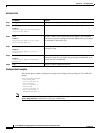
24-45
Cisco ASR 901 Series Aggregation Services Router Software Configuration Guide
OL-23826-09
Chapter 24 Configuring QoS
Configuring Quality of Service (QoS)
Configuring Class-Based Weighted Fair Queuing (CBFQ)
The Cisco ASR 901 supports Class-Based Weighted Fair Queuing (CBWFQ) for congestion
management.
Complete the following steps to configure CBWFQ.
Step 1 A class map contains match criteria against which a packet is checked to determine if it belongs to the
class. You can use class maps to define criteria that are referenced in one or more policy maps. Complete
the following steps to configure a class map.
a. Use the class-map command to create a class map.
Router(config)# class-map class1
Router(config-cmap)#
b. Use the match command to specify the match criteria for the class map. You can define a variety of
match criteria including CoS, DSCP, MPLS Exp, or QoS group value.
Router(config-cmap)# match qos-group 7
c. Use the exit command to exit class map configuration.
Router(config-cmap)# exit
Router(config)#
Step 2 Complete the following steps to configure a policy map and attach it to an interface.
Note The Cisco ASR 901 does not support the queue-limit commands. Only random-detect
discard-class-based is supported on GigabitEthernet Interfaces.
a. Use the policy-map command to define a policy map.
Router(config)# policy-map policy1
Router(config-pmap)#
b. Use the class command to reference the class map that defines the traffic to which the policy map
applies.
Router(config-pmap)# class class1
Router(config-pmap-c)#
c. Use the bandwidth command to specify the bandwidth allocated for the traffic class.
Router(config-pmap-c)# bandwidth percent 10
d. Use the exit command to exit the policy map class configuration.
Router(config-pmap-c)# exit
Router(config-pmap)#
e. Use the exit command to exit the policy map configuration.
Router(config-pmap)# exit
Router(config)#
f. Enter configuration for the interface to which you want to apply the policy map.
Router(config)# interface atm0/ima0


















